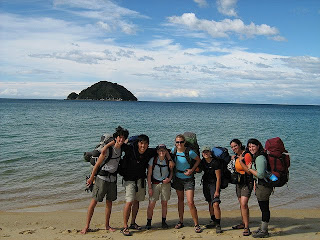 For most students, backpacking is a perfect mode of travel. It helps you save a ton of money compared to conventional modes of travel while providing a great a sense of thrill and adventure. But, every backpacker knows the secret to a successful trip is being prepared and taking the right safety precautions. Here is a checklist that helps ensure that every hiking excursion will be well planned and well executed.
For most students, backpacking is a perfect mode of travel. It helps you save a ton of money compared to conventional modes of travel while providing a great a sense of thrill and adventure. But, every backpacker knows the secret to a successful trip is being prepared and taking the right safety precautions. Here is a checklist that helps ensure that every hiking excursion will be well planned and well executed.- Dress Appropriately. Hikers know that the weather can often be unpredictable, especially in higher altitudes. Wearing multiple layers is the best way to stay prepared for any unforeseen changes in the climate. Removing top layers lets you quickly adapt to rising temperatures, while adding windproof, water-resistant top layers with good ventilations, will keep you warm and dry.
- Balance your load. Carrying an unbalanced pack is the quickest way to hurt your back, knees, or shoulders. Clothes and cooking essentials should be safely stored in the backpack's main compartment, while heavier, cumbersome items should be placed in the back. Essential items like sunglasses, maps, and flashlights can be stowed in outside pockets. Also, pack all clothes and food in water resistant plastic bags. If your pack should fall into a lake, or you experience an unexpected downpour, these items will remain dry.
- Bring plenty of food and water. Hiking can burn a lot of calories in one day, so backpackers should remember to pack plenty of carbohydrates that help replenish energy. Also, while water can be heavy to carry, getting dehydrated is a hiker's worst nightmare. If you are planning to hike for several days and there is a fresh water source in the area, like a like or moving river, consider bringing a water filtration system with you. This will reduce the amount of water you have to
carry, but keep you hydrated. Also, water takes longer to boil in higher altitudes, so consider taking food that doesn't require hot water, like sandwiches. - Travel together. Backpacking alone can be dangerous, especially in the winter and in rough terrains. Always hike with a partner to reduce the risk of getting lost or being stranded. And always remember to inform others of your scheduled route. This buddy system can help save your life in case of emergencies.
- Bring first aid kits. First aid, or emergency kits are essential for all backpacking trips. They should be tailored to address the needs of the individuals going on the trip, like their experience level and their age, as well as the expected terrain. Research any poisonous plants or animals that might live in the area, like poison oak or scorpions.
- Bring a map and compass. Every hiker should study a map of their proposed hike before embarking on the trip, and carry a map and compass during the trip. If members of the group become separated, they at least have the means to find their way to safety.
- Plan ahead of time. Planning the trip ahead of time will save backpackers time and energy. They should plan elements like realistic daily goals and emergency regrouping sites.
- Bring a basic repair kit. Sometimes backpack straps break, or camp stoves fail. Repair kits should include duct tape, a needle and thread, and simple tools. These things will come in handy should the shoe laces on your hiking books break, or your sleeping bag gets a rip.
- Wear sunscreen and glasses. While the weather in higher altitudes might be deceptively cool, the sun is still a hazard. All backpackers should wear sunscreen when hiking no matter the temperature. Also, snow can cause temporary blindness if continually looked upon without protective eyewear, so don those sunglasses, too!
- Bring plenty of fuel and an extra stove. Sometimes a stove breaks and can't be repaired and occasionally fuel canisters won't work properly. Bringing extra will ensure you can boil water and cook your food properly.
*About the author: This guest post is contributed by Roger Elmore, who writes on the topics of hotel management degree. He welcomes your comments at his email Id: rogerelmore24 @gmail.com.
*Image Credit: Photograph by argreen [via Flickr Creative Commons]
If you like this article, you may also like
No comments:
Post a Comment